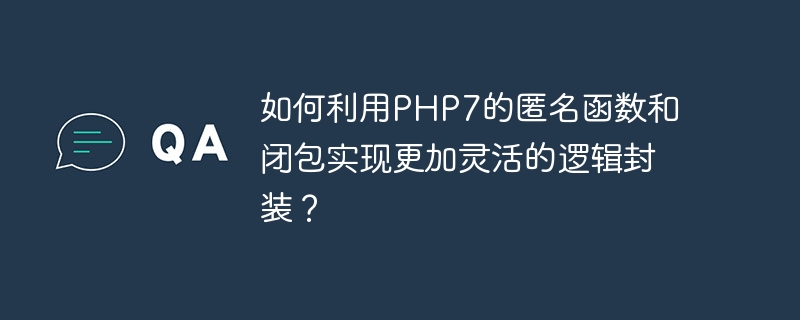Home >Backend Development >PHP7 >How to use PHP7's anonymous functions and closures to achieve more flexible logic encapsulation?
How to use PHP7's anonymous functions and closures to achieve more flexible logic encapsulation?
- 王林Original
- 2023-10-19 10:28:51760browse

How to use PHP7’s anonymous functions and closures to achieve more flexible logic encapsulation?
In PHP7, anonymous functions and closures are very powerful features. They can help us achieve more flexible and reusable code encapsulation. This article will introduce how to use PHP7's anonymous functions and closures to achieve these functions, and provide specific code examples.
A closure is a function that contains external environment variables. It can access and modify the values of external environment variables. Before PHP7, the use of closures was relatively cumbersome, and external variables needed to be introduced by using the use keyword. In PHP7, the static keyword was introduced, making the use of closures easier.
The following is a simple closure example that wraps the external variable $name inside the closure and returns an anonymous function.
function greeting($name) {
return function () use ($name) {
echo "Hello, $name!";
};
}
$greet = greeting("John");
$greet(); // 输出:Hello, John!In the above example, we defined a greeting function that returns a closure. Then, we introduce the external variable $name into the closure through the use keyword, and assign the closure to the variable $greet. Finally, when the $greet function is called, Hello, John! will be output.
An anonymous function is a function without a specific name in the code. It can be passed as a parameter to other functions, or assigned to a variable. Using anonymous functions allows you to encapsulate your logic in one place and call it wherever you need it.
The following is an example of using an anonymous function to find elements in an array under certain conditions:
$numbers = [1, 2, 3, 4, 5];
$filteredNumbers = array_filter($numbers, function ($number) {
return $number % 2 == 0;
});
print_r($filteredNumbers); // 输出:Array ( [1] => 2 [3] => 4 )In the above example, we use the array_filter function to $numbers Filter the array and only retain elements that meet the conditions. The anonymous function is passed to the array_filter function and is called on each iteration. By using anonymous functions, we can encapsulate the logic of filter conditions in one place, making the code clearer and easier to maintain.
In addition to being passed as parameters to other functions, anonymous functions can also be called where needed. Here is an example that shows how to use an anonymous function to implement the functionality of a callback function:
function applyOperation($numbers, $operation) {
$result = [];
foreach ($numbers as $number) {
$result[] = $operation($number);
}
return $result;
}
$numbers = [1, 2, 3, 4, 5];
$squareNumbers = applyOperation($numbers, function ($number) {
return $number * $number;
});
print_r($squareNumbers); // 输出:Array ( [0] => 1 [1] => 4 [2] => 9 [3] => 16 [4] => 25 )In the above example, the applyOperation function accepts an array and a callback function as parameters. It operates on each element in the array by calling a callback function and stores the result in a new array. When calling the applyOperation function, we pass it an anonymous function as a callback function and perform a squaring operation on each element in the array.
By using anonymous functions and closures, we can encapsulate code logic more flexibly and improve code reusability and maintainability. Whether you pass closures as parameters to other functions or use anonymous functions to implement the functionality of callback functions, you can easily implement it in PHP7. Of course, in actual development, we need to choose the best way to use anonymous functions and closures based on specific needs.
The above is the detailed content of How to use PHP7's anonymous functions and closures to achieve more flexible logic encapsulation?. For more information, please follow other related articles on the PHP Chinese website!

